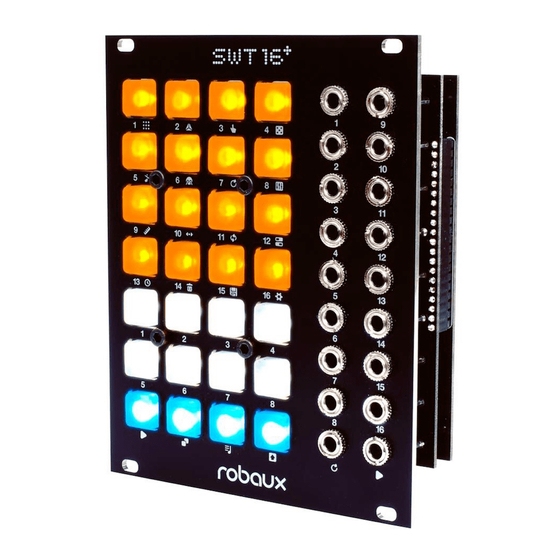
Table of Contents
Advertisement
Quick Links
Advertisement
Table of Contents

Summary of Contents for Robaux SWT16+
-
Page 2: Panel Description
Panel Description Buttons The controls are divided into three parts which are characterized by three different illumination colors. Orange The orange buttons 1-16 are the main control elements. Step Euclidean Classic step sequencing. Let math create your beat. Random Record with your fingertips. Randomly define your track. - Page 3 Blue The blue buttons are the function keys of the sequencer. Play Copy Starts or stops the sequencer. Copy sequences or patterns. Presets Modes/Patterns Call, save or delete presets. Select modes or patterns. Jacks The connections of the SWT16+ are divided into two different sections. Track Outputs The upper 16 jacks are assigned to the 16 different output tracks.
- Page 4 Create In the upper row are all functions for editing patterns. Here you can program the patterns step by step, use the Euclidean rhythm generator, play it on the fly or generate random patterns. Step Euclidean Classic step sequencing. Let math create your beat. Random Record with your fingertips.
- Page 5 Euclidean Rhythm Generator shift button Switch to this mode by holding down the euclidean rhythm generator button. while pressing the The Euclidean rhythm generator generates patterns on principle, which Euclid described for the first time around 300 B.C. The generator overwrites the current track with the generated pattern - this means that you can then adapt the pattern to your own needs.
- Page 6 shift button Switch to this mode by holding down the tap button. while pressing the In Tap mode, you can program your patterns on the fly. Each of the 16 keys represents one track. Play the buttons while the sequencer is running to program your pattern.
- Page 7 Performance In the second row, you can change the patterns temporarily. Here you can mute the patterns, make fills, reset the tracks or get a combination of many functions in the Performance Mode. You can also switch between the 8 shift button.
-
Page 8: Clock Reset
Clock Reset shift button Switch to this mode by holding down the clock reset button. while pressing the In clock reset mode, you can reset the clock of each track individually. Each of the 16 keys represents a trigger track. Hold the corresponding button to reset its clock. -
Page 9: Track Settings
Track Settings In the third row, you can set the step length, clock divider, the pattern offset, play direction, step reset, gate type and so on. Length Offset Set the duration of each track. Shift your patterns. Direction Values Adjust the play direction. Set the parameters of your tracks. - Page 10 Offset shift button Switch to this mode by holding down the offset button. while pressing the In offset mode, you can shift the steps of your track. Select the first white button to move the steps to the left. Select the second button to move the steps to the right.
- Page 11 3. Invert Gate Select the third white button for gate invert. If you have modules that require a dropping voltage as a trigger, you can make the appropriate setting here. Each of the 16 orange buttons represents a track. To toggle the Invert Gate, select or deselect one of them.
-
Page 12: Sequencer Settings
Sequencer settings In the fourth row, you can change the parameters of the sequencer. Choose between internal or external clock, delete tracks and patterns, write to memory or select various functions in the util menu. Autoclock Delete External or internal clock. Delete everything. - Page 13 Delete shift button Switch to this mode by holding down the delete button. while pressing the In delete mode you can delete individual tracks as well as patterns from the current preset. Press on a track or pattern to delete it. A confirmation prompt appears to make sure you do not accidentally delete anything.
- Page 14 Low Latency Mode Press the third button to set the latency of the sequencer. The sequencer needs about two milliseconds to calculate and output all steps. You can decrease this time to 0.45ms and enable a lookahead calculation. AutoRun With the fourth button you determine whether the sequencer should start when an external clock signal arrives, or whether you want to start the sequencer manually via the play button.
- Page 15 Presets presets button. Switch to this mode by holding down the The SWT16+ can store up to 16 presets. These presets contains all the pat- terns and settings of the 16 tracks as well as the sequencer settings. You can reach these presets by holding down the preset button. The orange buttons 1-16 are the memory locations.
- Page 16 About The SWT16+ is a 16-track Eurorack step sequencer with up to 64 steps per track. The module makes it possible to create up to 8 different patterns which can stored in a total of 16 presets. Programmable like a classic TR machine, the SWT16 can be used not only for triggering drum sounds but also envelopes or other modulation sources.





Need help?
Do you have a question about the SWT16+ and is the answer not in the manual?
Questions and answers